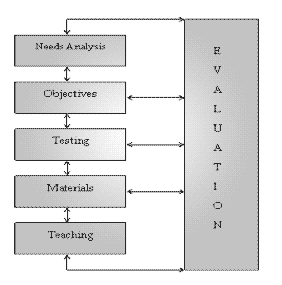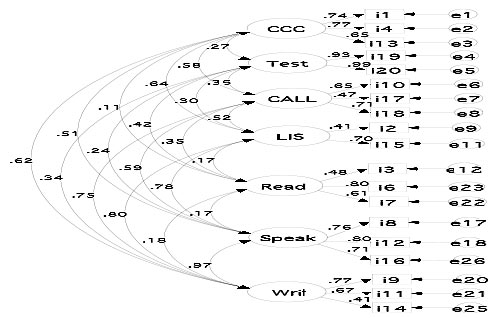| Item # |
Items |
M |
SD |
Factor
Pattern |
| Section 1: Culture-oriented Course (α = .76) |
| 1. |
I need to learn concepts in cross-cultural communication such as cultural values. |
4.69 |
0.95 |
.74 |
| 4. |
I need to practice many activities that make me understand my own culture and aware of cultural differences. |
4.42 |
1.08 |
.77 |
| 13. |
I need to learn how to handle situations when I encounter cross-cultural differences. |
4.56 |
1.01 |
.65 |
| Section 2: CALL Course (α = .63) |
| 10. |
I need learn how to make a web page in English. |
3.07 |
1.24 |
.65 |
| 17. |
I need to take a class that uses authentic audio-visual materials such as videos, CDs, and audio. |
4.87 |
1.02 |
.47 |
| 18. |
I need to take a class that uses computers for learning. |
3.96 |
1.14 |
.71 |
| Section 3: Listening Course (α = .44) |
| 2. |
I need to practice listening to be able to understand stress pattern and intonation. |
5.08 |
0.90 |
.41 |
| 5. |
I need to practice watching dramas in English in order to be able to understand the content. |
4.69 |
1.04 |
* |
| 15. |
I need to practice listening extensively to get the main ideas. |
4.75 |
0.98 |
.70 |
| Section 4: Reading Course (α = .65) |
| 3. |
I need to learn reading skills such as reading rapidly and getting the gist. |
4.64 |
0.90 |
.48 |
| 6. |
I need to practice reading by focusing on the grammar of English texts and translating them into Japanese. |
3.79 |
1.12 |
.80 |
| 7. |
I need to study the structures of English sentences. |
3.95 |
1.00 |
.61 |
| Section 5: Speaking Course (α = .80) |
| 8. |
I need to learn to discuss issues effectively in English. |
4.33 |
1.20 |
.76 |
| 12. |
I need to practice making a speech and presenting ideas in English. |
4.42 |
1.20 |
.80 |
| 16. |
I need to take a class in which my final grading is decided based on my score on test performance such as a speech. |
4.14 |
1.07 |
.71 |
| Section 6: Test-preparation course (α = .96) |
| 19. |
I need to take a class where I solve many TOEIC, TOEFL, and STEP questions. |
4.81 |
1.16 |
.93 |
| 20. |
I need to learn test-taking strategies to solve problems in TOEIC, TOEFL, and STEP. |
4.81 |
1.19 |
.99 |
| Section 7: Writing Course (α = .64) |
| 9. |
I need to practice writing papers in English. |
4.12 |
1.17 |
.77 |
| 11. |
I need to practice writing business letters in English. |
3.71 |
1.29 |
.67 |
| 14. |
I need to take a class in which my final grading is decided based on the result of my paper. |
4.11 |
1.05 |
.41 |


 PDF Version
PDF Version

